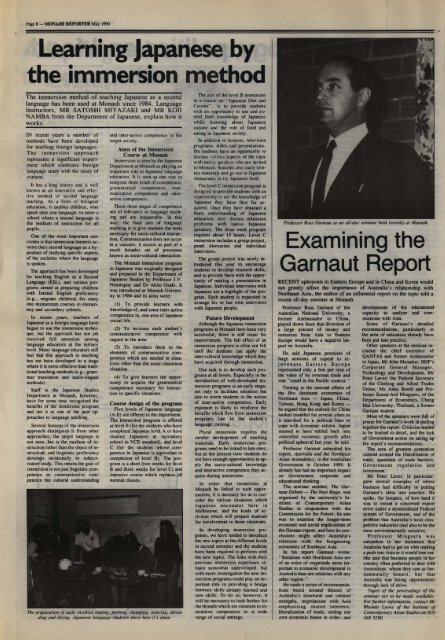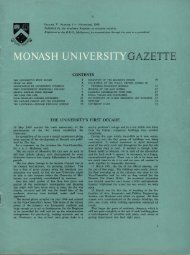Pia, - Adm.monash.edu.au - Monash University
Pia, - Adm.monash.edu.au - Monash University
Pia, - Adm.monash.edu.au - Monash University
Create successful ePaper yourself
Turn your PDF publications into a flip-book with our unique Google optimized e-Paper software.
Page 8 - MONASH REPORTER May 1990<br />
, <br />
Learning Japanese by <br />
the immersion method <br />
The immersion method of teaching Japanese as a second<br />
language has been used at <strong>Monash</strong> since 1984. Language<br />
Instructors, MR SATOSHI MIYAZAKI and MR Kon<br />
NAMBA from the Department of Japanese, explain how it<br />
works.<br />
IN recent years a number of<br />
methods have been developed<br />
for teaching foreign languages.<br />
The immersion approach<br />
represents a significant experi·<br />
ment which combines foreign<br />
language study with rhe study of<br />
content.<br />
It has a long history and is well<br />
known as an innovative and effective<br />
method of second language<br />
teaching. As a form of bilingual<br />
<strong>edu</strong>cation. it enables children. who<br />
speak only one language. to enter a<br />
school where a second language is<br />
the medium of instruction for all<br />
pupils.<br />
One of the most imponant Qui·<br />
comes is that immersion learners 3C<br />
~uire their second language as a byproduct<br />
of studying specific aspecrs<br />
of the societies where the language<br />
is spoken.<br />
The approach has been developed<br />
for leaching English as a Second<br />
Language (ESL). aod various programs<br />
aimed at preparing children<br />
with limited English proficiency<br />
(e.g.. migrant children) for entry<br />
into mainstream courses in elementary<br />
and secondary schools.<br />
In recent years. teachers of<br />
Japanese as a foreign language have<br />
begun to use the immersion technique,<br />
but the approach has not yet<br />
received full attention among<br />
language <strong>edu</strong>cators at the tertiary<br />
level. Many language <strong>edu</strong>cators still<br />
feel that this approach to teaching<br />
has not been developed to a stage<br />
where it is more effective than traditional<br />
teaching methods (e.g . . grammar<br />
translation and <strong>au</strong>dio-lingual<br />
merhods).<br />
Staff in the Japanese Studies<br />
Department at <strong>Monash</strong>, however.<br />
have for some time recognised the<br />
benefits of the immersion program<br />
and see it as one of the new approaches<br />
to language teaching.<br />
Several features of the immersion<br />
approach distinguish it from other<br />
approaches; the target language is<br />
not seen. bur is the medium of instruction<br />
rather than the object of instruction;<br />
and linguistic proficiency<br />
develops incidentally to subjectmatter<br />
study. This means the goal of<br />
immersion is not just linguislic competence<br />
or communicative competence<br />
but cullural understanding<br />
and inter-active competence in the<br />
target society.<br />
Aims of the Immersion<br />
Course at <strong>Monash</strong><br />
Immersion is seen by the Japanese<br />
Depanment al <strong>Monash</strong> as playing an<br />
important role in Japanese language<br />
<strong>edu</strong>calion. It is seen as one way 10<br />
integrate three kinds of competence;<br />
grammatical competence. communicative<br />
competence and interactive<br />
competence.<br />
These three stages of competence<br />
are of relevance to language teaching<br />
and are inseparable. In this<br />
way. the final aim of language<br />
teaching is to give students the tools<br />
necessary for socio-cultural interaction.<br />
Communication does not occur<br />
in a vacuum; it occurs as part of a<br />
much broader set of processes<br />
known as socio-cultural interaction.<br />
The <strong>Monash</strong> immersion program<br />
in Japanese was originally designed<br />
and prepared in the Depanment of<br />
Japanese Studies by Professor J. V.<br />
Neustupoy aod Dr Akito Ozaki. It<br />
was introduced at <strong>Monash</strong> <strong>University</strong><br />
in 1984 and its aims were:<br />
(I) To provide learners with<br />
knowledge of. and some inter-active<br />
competence in, one area of Japanese<br />
social life.<br />
(2) To increase each student's<br />
communicative competence with<br />
regard to the area.<br />
(3) To introduce them to the<br />
elements of communicative competence<br />
which are needed in situations<br />
other than the usual classroom<br />
situation.<br />
(4) To give learners the opportunity<br />
to acquire the grammatical<br />
competence necessary for interaction<br />
in specific situations.<br />
Course design of the program<br />
Five levels of Japanese language<br />
(A-E) are offered in the depanment.<br />
The immersion program is offered<br />
at level B (for the students who have<br />
completed Japanese level A or have<br />
studied Japanese at secondary<br />
school to VCE sraodard). and level<br />
C (for the students whose competence<br />
in Japanese is equivalent to<br />
completion of level B). The program<br />
is a short (two weeks for level<br />
B and rhree weeks for level C) and<br />
intensive course which replaces all<br />
normal classes.<br />
The preparation ofsu.'~hi invoJves cutting, peeling. chopping, mincing. shredding<br />
and dicing. Japanese language students show how it's done.<br />
The aim of Ihe level B immersion<br />
in a course on "Japanese Diet and<br />
Cuisine". is 10 provide students<br />
with an opportunity to use and extend<br />
their knowledge of Japanese<br />
while learning about Japanese<br />
cuisine and the role of food and<br />
eating in Japanese society.<br />
In addition to lectures. television<br />
programs. slides and presentations.<br />
the students have an opportunity to<br />
discuss va rious aspects of the topic<br />
with native speakers who ate invited<br />
to <strong>Monash</strong>. Students also study writlen<br />
materials and go out to Japanese<br />
rest<strong>au</strong>r.mts to try Japanese food.<br />
The level C immersion program is<br />
designed to provide students with an<br />
opportunity to use the knowledge of<br />
Japanese they have thus far acquired.<br />
Once they have obtained a<br />
basic understanding of Japanese<br />
<strong>edu</strong>cation. they discuss <strong>edu</strong>cation<br />
problems with native Japanese<br />
speakers. The three week program<br />
requires abour 15 hours. Level C<br />
immersion includes a group project,<br />
panel discussion and individual<br />
interviews.<br />
The group project was newly introduced<br />
this year to encourage<br />
students to dev.elop research skills,<br />
aod to provide them with the opportunity<br />
of making a presentation in<br />
Japanese. Individual interviews with<br />
Japanese are a highlight of the program.<br />
Each student is requested to<br />
arrange his or her own interviews<br />
with Japanese people.<br />
Future Development<br />
Although the Japanese immersion<br />
programs at <strong>Monash</strong> have been very<br />
successful, there is still room for<br />
improvement. The full effect of an<br />
immersion program is often not felt<br />
until the students can apply the<br />
inter-cultural knowledge which they<br />
have acquired through immersion.<br />
One task is to develop such programs<br />
al all levels. Especially in the<br />
introduction of well-developed immersion<br />
programs at an early stage,<br />
not only to facilitate retention but<br />
also to orient students to the notion<br />
of inter-active competence. Early<br />
exposure is likely to reinforce the<br />
benefits which flow from immersion<br />
programs late in the student's<br />
language training.<br />
Plural immersion requires the<br />
careful development of teaching<br />
materials. Early immersion programs<br />
need to be linked to late ones,<br />
but at the present time students do<br />
not have enough opportunities to apply<br />
the socio...:uitural knowledge<br />
and interactive competence they acquire<br />
during immersion.<br />
In order that immersion at<br />
<strong>Monash</strong> be linked to such oppor- ·<br />
tunities, it is necesary for us to consider<br />
the various situations which<br />
Japanese encounter here in<br />
MelbOurne, aod the kinds of ac·<br />
tivities which will prepare students<br />
for involvement in those situations.<br />
In developing immersion programs,<br />
we have tended to introduce<br />
the new topics at the different levels<br />
in second semester and the students<br />
have been required 10 perform with<br />
the new topics. The links with their<br />
previous immersion experience remain<br />
somewhat undeveloped, but<br />
with more investigation the new immersion<br />
programs could play an imponant<br />
role in providing a bridge<br />
between skills already learned and<br />
new skills. To do so, however. it<br />
will be necessary to look further for<br />
the threads which are common to interactive<br />
competence in a wide<br />
range of social settings . .<br />
Professor Ross Garn<strong>au</strong>t at an all-day seminar held recently at <strong>Monash</strong>.<br />
Examining the <br />
Garn<strong>au</strong>t Report <br />
RECENT upheaval. in Eastern Europe and in China and Korea would<br />
not greatly affect the imponance of Australia'. relationship with<br />
Northeast Asia, the <strong>au</strong>thor of an influential repon on the topic told a<br />
recent a11.

















